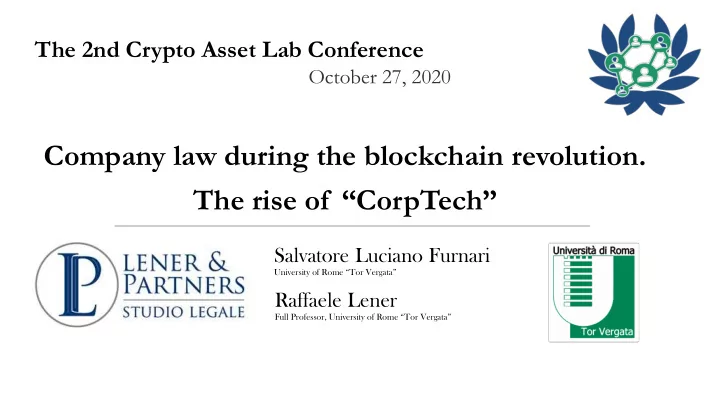

The 2nd Crypto Asset Lab Conference October 27, 2020 Company law during the blockchain revolution. The rise of “CorpTech” Salvatore Luciano Furnari University of Rome “Tor Vergata” Raffaele Lener Full Professor, University of Rome “Tor Vergata”
TABLE OF CONTENTS 1. Introduction 2. Tokenization of company’s participations 3. Exercise of rights through DLT 4. DLT vs deepfake technology 5. Final remarks
1. Introduction The CorpTech “myth” CorpTech technological solutions applied to corporate governance systems E.g.: registration of company shares on a public blockchain; voting using tokens; balance sheets on the blockchain; etc. Can these solutions find application in the real life? 3
Aim of this paper is Answer two questions: According to Italian Company Law: It is possible to issue equity tokens? Can tokens be used to exercise economic or administrative rights? Provide one solution: The use of DLT against the perils of deepfake technology 4
2. Possibility of issuing equity tokens How companies’ participations are represented and can circulate Companies Limited by Shares (S.p.A.) Securized shares ( Azioni cartolarizzate ) Not-securized share ( Azioni non-cartolarizzate ) Limited Liability Companies (S.r.l.) Traditional regime Alternative Regime (Art. 100-ter TUF, 2015) 5
Issuing Equity Tokens in S.p.A. Regime: Azioni cartolarizzate Shares incorporated in physical documents ( titoli di credito ) Difficulties in considering tokens as ‘physical’ Token ≠ Credit titles In this regime shares cannot be incorporated in tokens 6
Issuing Equity Tokens in S.p.A. Regime: Azioni non cartolarizzate Shares circulation is based on the Shareholder Book Transfer by consensus on it registered in the S.B. Shareholder Book can be kept using electronic meas (art. 2215-bis c.c.) Equity Tokens can be issued in this regime 7
How: Equity Tokens are just a mean of communication 8
Issuing Equity Tokens in S.r.l. Regime: Traditional Regime Quotas circulation is based on the Company Register Transfer communications must be sent by a public notary or by a dottore commercialista The system is too much centralized and intermediated to be tokenized 9
However…. This solution should let Equity Tokens be issued but only as a mean of communication 10
Issuing Equity Tokens in S.r.l. Regime: Alternative Regime Regime introduced in 2015 for equity crowdfunding campaigns (Art. 100-ter TUF) A private intermediary has the task to manage the transfers being the only shareholder in the Company Register The intermediary is free to adopt a DLT system and so to issue equity tokens Tokens can be only a mean of communication 11
To sum up the first part.. Q1: According to Italian Company Law, it is possible to issue equity tokens? Companies Limited by Shares (SPA) R. of azioni cartolarizzate No, tokens are not credit title R. of azioni non-cartolarizzate Yes, but just as a mean of communication Limited Liability Companies (SRL) Traditional regime Maybe, but just as a mean of communication Alternative Regime Yes, but just as a mean of communication 12
3. Exercising economic and administrative rights Economic rights Right to receive dividens Administrative rights Right to vote Right to intervention within the meeting 13
Exercise of economic rights No legal limitations (ex ante) BUT DLT implies the impossibility to claim back distributions Such mechanism should be implemented to be activated under specific events There is the need to create a link between cash and cryptocurrencies Corruption of the «bridge» between on- and off-chain Technological limits(?) 14
Administrative rights No legal limitations (at all) Voting using DLT shall be provided in the bylaws BUT Strong technological limits (!) e.g.: Problem of trasparency of permissionless DLT Solution: only record the hash 15
4. DLT for participations at distance Emergency situations require reunions to be held at distance Until few years ago, seeing a person face or hearing his voice was a guarantee Deepfake technology nullifies this guarantee 16
What is deepfake technology Solution: DLT and identification tokens 17
5. Final remarks CorpTech myth is not real yet Legal obstacles (Part I) Technological limitation (Part II) Concrete applicable solutions (Part III) 18
What we can do about it? Update the laws Innovate technology BUT ALSO Change our behaviour (i.e. using criptocurrencies) 19
Thank you! salvatore.furnari@leplex.it References: DE L UCA N., Documentazione crittografica e circolazione della ricchezza assente , Rivista di Diritto Civile, 2020 E NRIQUES L. and Z ETZSCHE D., Corporate technologies and the Tech Nirvana Fallacy , European Corporate Governance Institute (ECGI) - Law Working Paper No. 457/2019, 2019 20
Recommend
More recommend